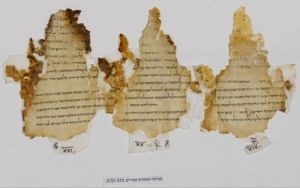Ritual Purity and the Presence of the Lord, Lawrence H. Schiffman, Reclaiming the Dead Sea Scrolls, Jewish Publication Society, Philadelphia 1994.
And you shall construct a barrier around the sanctuary one hundred cubits wide which shall divide between the holy sanctuary and the city, so that they will not enter suddenly into the midst of My sanctuary, so that they not profane it. And they shall consider My sanctuary holy and revere My sanctuary because I dwell in their midst. (TEMPLE SCROLL 46-9–12)
This barrier was intended to separate the Temple and its courtyards from the rest of the Temple Mount. Its function was to ensure the holiness of the three courtyards surrounding the Temple. The text specifically informs us why it is needed- so that the Temple (here the entire precincts) will not be defiled by sudden entry into the courtyards.
In this context, the Temple Scroll articulates its notion of sanctity- the worshiper’s awe of the sanctuary where God’s indwelling presence resides. This presence and the sanctity it engenders radiate from the Temple to the rest of the Land of Israel, thus endowing it and the people who dwell on it with holiness and sanctity.
The scroll returns to this same theme in the next column-
And the city which I will sanctify to cause My name and My sanctu[ary to dwell within it] shall be holy and pure from every type of impurity by which one can become impure. And everything which shall enter it shall be pure. (TEMPLE SCROLL 47-3–6)
The city in which God’s presence dwells must be holy and free of all impurity. This law extends to everything in it and everything brought into it. The text goes on to require the purity of foodstuffs and to prohibit bringing into the Temple area the skins of animals not sacrificially slaughtered, for it is impossible to expect that God will coexist with impurity of any kind.
Even the hides of animals made into bags or sacks for transporting goods must be pure-
Therefore, all pure food for the Temple you shall bring in hides of (animals slaughtered in) the Temple so as not to render impure My Temple and My city, in which I dwell, with the hides of your abominations. (TEMPLE SCROLL 47-17–18)
The author, much like the compilers of the Halakhic Letter, carried on a sustained polemic against both the Hasmonaeans and the Pharisees. However, his polemic had a unique style. Instead of condemning his opponents and castigating them, the author/redactor articulated his ideas in the form of an imitation Torah so as to present those ideas as the word of God, revealed directly at Sinai.
Against the Hasmonaeans, in the section termed by scholars the Law of the King, he argued for a new system of government and for the separation of the roles of kingship and priesthood. Against the Pharisees, he argued about numerous legal matters and interpretations of Scripture, sometimes espousing views we know to be Sadducean.
Yet his polemic went even further. He called for a new Temple building and for new settlement patterns as well. In discussing the Temple building, settlement patterns, and his approach to the Land of Israel, the author took a distinctly utopian view. His plan envisioned concentric spheres of holiness, beginning with the Temple complex at the center and extending outward to the tribal allotments, to the cities of Israel, and into the houses where the people dwelled. He was also concerned with the sanctity of the entire land as sacred space.
Pages 264-266
What do you want to know?
Ask our AI widget and get answers from this website
